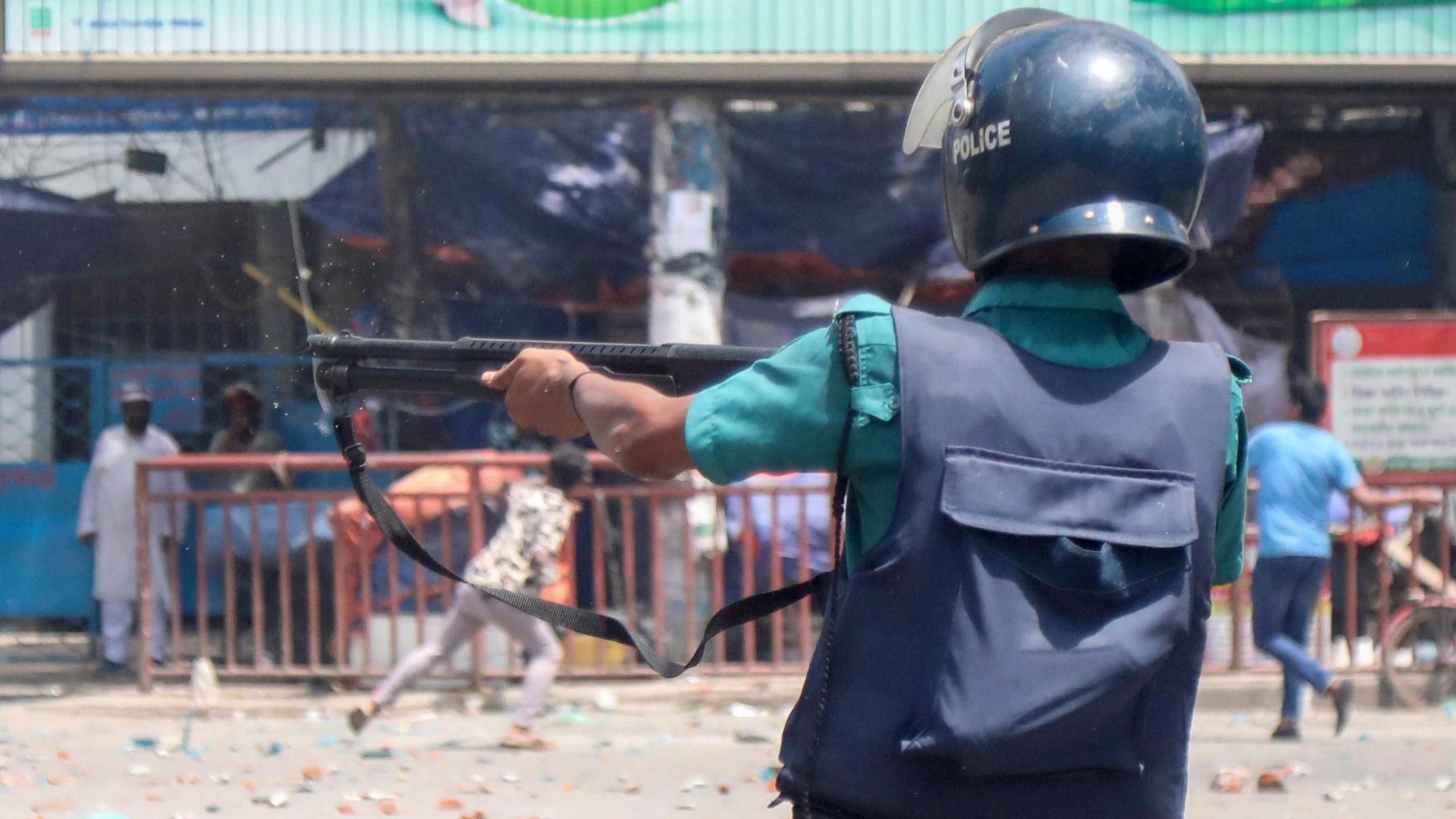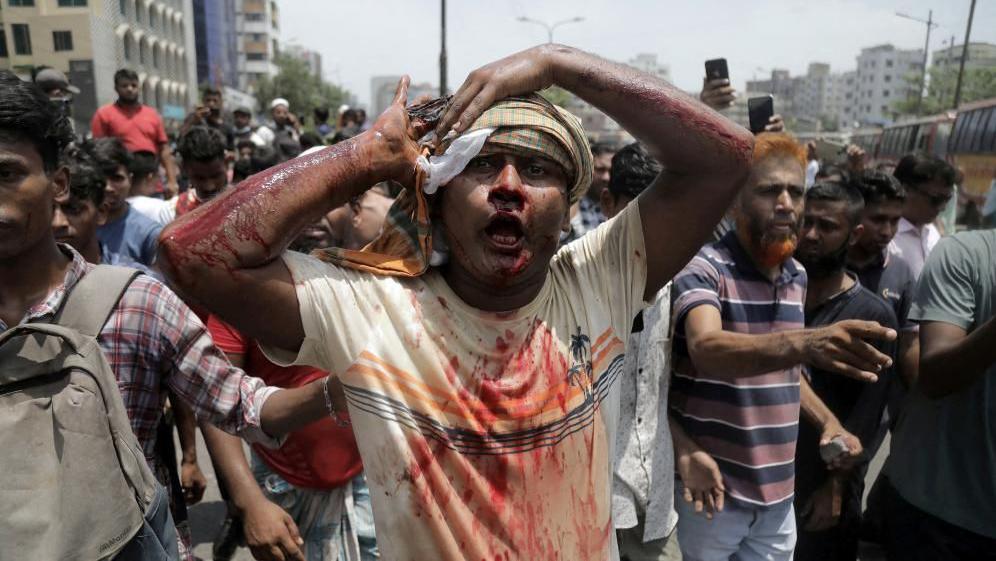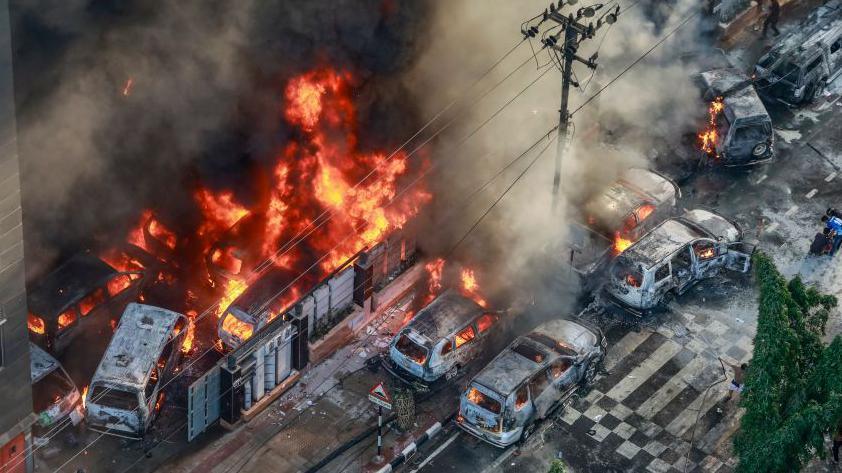Videos reveal brutality that left scores dead in Bangladesh protests
Videos of police action during protests show shots fired at protesters
- Published
An image is worth a thousand words – sometimes, it can even stir a nation.
In Bangladesh, it was the image of university student Abu Sayeed standing with open arms, stick in hand, facing heavily-armed police alone which many credit as the turning point in the recent widespread protest in the country against quotas in government jobs.
Within seconds, as the video shows, the young man was shot at – but still he continues to stand, even as the sounds of more shots ring out. He collapses a few minutes later.
The 16 July incident quickly went viral, triggering more students to jump into the agitation against reservations in civil service jobs for the family members of the veterans of the country’s independence war in 1971.
What followed were days of unrest, marked by an unprecedented ferocity of violence. Bangladesh security agencies are accused of a disproportionate use of force - firing tear gas, rubber bullets, pellet guns, sound grenades and live rounds - a charge they deny. A curfew was eventually brought in, with a shoot-on-sight order.
The highly-respected Bengali daily Prothom Alo and the AFP news agency say more than 200 people were killed in the violence, including several students and three police officers. Official government statistics stand at 147, according to the home minister.
But exact details - and more videos showing what was happening on the streets - have been slow to emerge, in part due to the internet shutdown imposed by the government.
However, since the broadband was partially restored last week, more visuals of the violence have come to light.
In one, substantiated by the BBC’s Verify Team, a young man is trying to pull his injured friend to safety in the Jatrabari area of the capital Dhaka.
Within seconds, a plain-clothes officer with a helmet appears to be firing in the direction of the two. After a while, the young man leaves his mortally wounded friend and sprints away to safety.
What both this and the video of Abu Sayeed show are “unlawful killings”, Irene Khan, a senior UN expert told the BBC.
“Abu Sayeed was not posing any threat to police. But what they do is shoot him point blank, it is a clear display of unjustified, disproportionate violence,” Ms Khan, the Special Rapporteur on the promotion and protection of the right to freedom of opinion and expression, explained.

Bangladesh security agencies are accused of responding disproportionately
Bangladeshi junior minister of information and broadcasting Mohammad Ali Arafat agreed the video of Mr Sayeed being shot appeared “unlawful”.
“That was absolutely vivid and clear,” he said. “The guy was standing stretching his hands and chest, very short distance he was shot.”
Mr Arafat added the incident would be investigated, saying an independent judicial committee had been formed to investigate.
A third video checked and substantiated by the BBC’s Verify Team showed heavily armed troops firing at a group of protesters at a distance in the Mohammadpur area of Dhaka.
But a spokesman for Dhaka Metropolitan police, Faruk Hossain, defended their actions, saying police fired only in self-defence.
“Police use force to save life and property. Any police officer opened (fire) only when it is questioned of private (self) defence situation,” Mr Hossain said in a WhatsApp message.
Officials produced videos of another incident, which appears to show a crowd targeting a police van and later beating up an officer inside the van in the Uttara area of Dhaka.
“They [protesters] killed a police officer and hung him upside down in the Jatrabari area of Dhaka,” Mr Arafat alleged. A ruling party activist was also allegedly beaten to death.
The violence was “not one-sided - people need to see both sides, to see what happened”, Mr Arafat said, adding security forces were outnumbered and attacked in several places because they were not allowed to open fire.
Protesters in Dhaka attack a police vehicle
A second video sent by the government showed an injured police officer being carried away by his colleagues.
The government alleges supporters of the main opposition Bangladesh Nationalist Party (BNP) and the Jamaat-e-Islami party infiltrated the student protests and launched violent attacks on security forces and set fire to state property.
Critics dismiss the claim as an attempt by the governing Awami League to divert attention.
Since the protests died down, activists and local media say the government has unleashed a crackdown by arresting more than 9,000 people, including opposition supporters.
Student protest leaders have also been rounded up - a move the government said was “for their own safety”.
With the government going hard on the demonstrators, experts warn that Bangladesh could witness further unrest.
“There is no trust between the state and the people, you can see that. That’s why you are having these protests and the terrible situation,” the UN expert Ms Khan said.
Bin Yamin Mollah, one of the coordinators of the student movement, who is in hiding “living in fear” of arrest, echoed her sentiment.
“The government has betrayed us,” he told the BBC.
Additional reporting by BBC Bengali Service, Dhaka
Related topics
- Published24 July 2024

- Published6 August 2024
